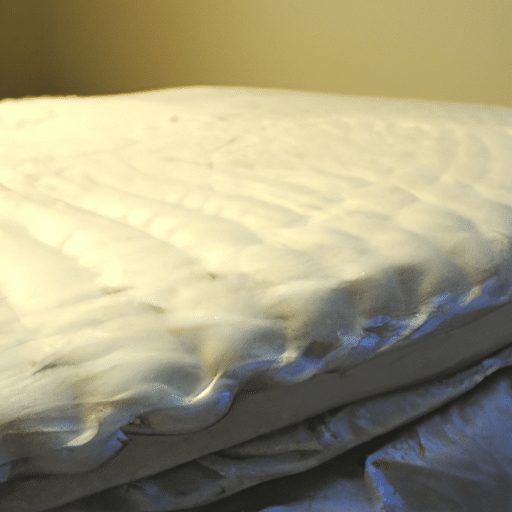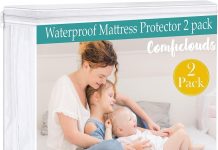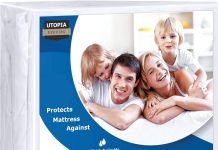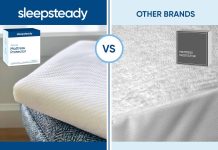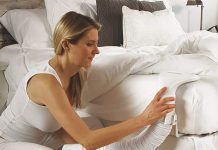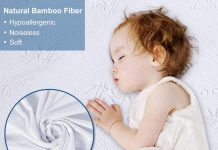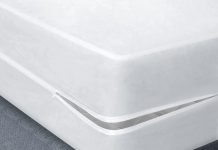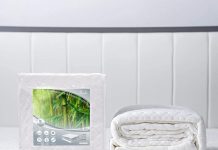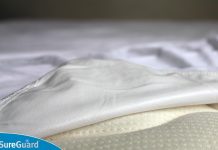Have you ever wondered whether you should use a mattress protector on top of a mattress pad? It’s a question that many of us have pondered, unsure of the best way to protect our mattresses. In this article, we aim to provide some clarity on the matter and help you make an informed decision on whether to use both or just one of these bedding accessories. So, let’s dive in and explore the world of mattress protection!
Review contents
What is a mattress protector?
A mattress protector is a removable cover that is placed over a mattress to protect it from damage and keep it in good condition. It acts as a barrier between the mattress and external elements such as spills, stains, allergens, dust mites, and even bed bugs.
Definition
A mattress protector is a thin layer of material, usually made of waterproof or water-resistant fabric, that fits snugly over the mattress. It typically encloses the entire mattress, including the top, sides, and bottom, and is secured in place with elasticized corners or straps.
Purpose
The main purpose of a mattress protector is to safeguard the mattress from spills, stains, and other potential sources of damage. It acts as a barrier against liquids, preventing them from reaching the mattress and causing stains or absorbing into the inner layers. Additionally, mattress protectors can also provide protection against allergens, dust mites, and bed bugs, improving the overall hygiene of the sleeping surface.
Types of mattress protectors
There are various types of mattress protectors available, each offering different features and functionalities. Some common types include:
- Waterproof mattress protectors: These protectors are designed to be impermeable to liquids, offering complete protection against spills and accidents.
- Breathable mattress protectors: These protectors are made from fabrics that allow air to circulate, promoting ventilation and preventing heat buildup.
- Allergen-proof mattress protectors: These protectors create a barrier against allergens such as dust mites, pollen, and pet dander, reducing the risk of allergies.
- Anti-bed bug mattress protectors: These protectors are specifically designed to prevent and control bed bug infestations, keeping the mattress safe and free from these pests.
What is a mattress pad?
A mattress pad, also known as a mattress topper, is an additional layer of cushioning that is placed on top of the mattress for added comfort and support. It is typically thicker than a mattress protector and is meant to enhance the overall feel of the sleeping surface.
Definition
A mattress pad is a removable layer that sits directly on top of the mattress, providing an extra layer of padding and softness. It is often made of materials such as foam, polyester, or feather fill, and is held in place with corner straps or fitted sheet-like pockets.
Purpose
The primary purpose of a mattress pad is to improve the comfort level of the mattress. It adds an additional layer of softness and support, enhancing the overall sleeping experience. Mattress pads can also help alleviate pressure points and provide extra cushioning for individuals with joint or muscle pain.
Types of mattress pads
There are various types of mattress pads available, each offering a different level of comfort and support. Some common types include:
- Memory foam mattress pads: These pads are made from memory foam, which contours to the body’s shape and provides excellent pressure relief.
- Pillow-top mattress pads: These pads have a layer of extra padding on top, mimicking the feel of a plush pillow, and providing a luxurious sleeping surface.
- Cooling mattress pads: These pads are designed to regulate body temperature during sleep, using cooling gel or breathable fabrics to dissipate heat and keep the sleeper cool.
- Wool mattress pads: These pads are made from naturally breathable wool fibers, offering temperature regulation and moisture-wicking properties.
Differences between mattress protector and mattress pad
While both a mattress protector and a mattress pad serve purposes related to the mattress, there are several key differences between the two in terms of function, material, thickness, comfort, and price.
Function
A mattress protector primarily serves as a protective barrier for the mattress, preventing damage from spills, stains, and allergens. On the other hand, a mattress pad is primarily used to enhance comfort and provide additional cushioning.
Material
Mattress protectors are often made of waterproof or water-resistant materials like polyester or vinyl to protect against liquids. In contrast, mattress pads are made from a variety of materials, including memory foam, polyester, feather fill, or wool, depending on the desired level of comfort and support.
Thickness
Mattress protectors are typically thin and fit snugly over the mattress, adding minimal extra thickness. In contrast, mattress pads are thicker and designed to add an additional layer of cushioning and support to the sleeping surface.
Comfort
While a mattress protector focuses more on functionality and protection, a mattress pad is specifically designed to enhance comfort. It provides a softer and more plush sleeping surface, making it ideal for individuals who prefer a cushioned feel.
Price
Mattress protectors are generally more affordable than mattress pads, as they primarily serve a protective function. Mattress pads, on the other hand, can vary widely in price depending on the material, thickness, and brand.
Reasons to use a mattress protector
Using a mattress protector offers various benefits beyond just protecting the mattress from spills and stains. Here are some compelling reasons to consider using a mattress protector:
Protection against spills and stains
Our mattresses are prone to accidents and spills, whether it’s a late-night beverage mishap or a pet jumping onto the bed with muddy paws. A mattress protector acts as a waterproof barrier, preventing liquids from seeping into the mattress and causing permanent stains or damage. It helps to preserve the mattress’s appearance and extend its lifespan.
Prevention of allergens and dust mites
Dust mites, allergens, and other microscopic pests can easily find their way into our mattresses, leading to allergies and respiratory issues. A mattress protector creates a physical barrier, preventing these irritants from infiltrating the mattress and reducing the risk of allergic reactions. For individuals with allergies or asthma, a mattress protector is an essential investment in their health and wellbeing.
Longevity of mattress
Replacing a mattress can be a significant expense, so it’s crucial to take steps to prolong its lifespan. A mattress protector acts as a shield, protecting the mattress from wear and tear, stains, and spills that can lead to premature deterioration. By investing in a good quality mattress protector, you can help extend the life of your mattress, saving you money in the long run.
Warranty requirements
Many mattress warranties come with specific guidelines and requirements to maintain the warranty validity. One common requirement is the use of a mattress protector. By using a mattress protector, you ensure that your warranty remains valid and any potential claims are not voided due to neglecting this essential precaution.
Advantages of using a mattress pad
In addition to a mattress protector, using a mattress pad can offer several advantages that enhance the overall sleeping experience. Here are some reasons why you might want to consider using a mattress pad:
Enhanced comfort and softness
If you find your mattress to be too firm or lacking in comfort, a mattress pad can provide an extra layer of cushioning and softness. Depending on the type and thickness of the pad, it can transform even the most unyielding mattress into a more comfortable and cozy sleeping surface. A mattress pad can make a significant difference in the overall feel of your bed, allowing you to enjoy a more restful night’s sleep.
Extra support and cushioning
For individuals who suffer from joint or muscle pain, a mattress pad with added support can offer relief and improved comfort. Memory foam mattress pads, for example, contour to the body’s shape and provide excellent pressure point relief, allowing for better spinal alignment and reducing pain and discomfort.
Temperature regulation
Some mattress pads are designed with cooling properties, using materials such as cooling gel or breathable fabrics to regulate body temperature during sleep. If you tend to sleep hot or live in a warm climate, a cooling mattress pad can help dissipate heat and keep you comfortably cool throughout the night.
Prolonging the life of the mattress
Similar to a mattress protector, a mattress pad can act as an extra layer of protection for your mattress. It helps to shield the mattress from physical wear and tear caused by body weight and movement. By reducing direct contact between the mattress and sleeper, a mattress pad can help to maintain the mattress’s structural integrity, potentially extending its lifespan.
Using a mattress protector and mattress pad together
While a mattress protector and mattress pad serve different functions, there may be instances where using them together can provide added benefits.
Order of placement
When using a mattress protector and mattress pad together, the most common configuration is to place the mattress protector first, directly onto the mattress, followed by the mattress pad on top. This arrangement ensures that the mattress is adequately protected from spills and stains while still benefiting from the added comfort and cushioning of the mattress pad.
Benefits of combining
By combining a mattress protector and mattress pad, you reap the advantages of both. The mattress protector offers protection against spills, stains, and allergens, while the mattress pad enhances comfort and support. This combination can create a clean, hygienic, and comfortable sleeping environment.
Potential drawbacks
There are a few potential drawbacks to using a mattress protector and mattress pad together. The additional layers can slightly alter the overall feel and firmness of the mattress. Some individuals may find that the combination makes the bed too soft or that the added thickness affects their preferred sleeping position. It’s essential to consider personal comfort preferences and make adjustments as needed.
Replacing or washing the mattress protector and mattress pad
Regular cleaning and proper maintenance of the mattress protector and mattress pad are crucial to ensure their effectiveness and longevity.
Frequency of replacement
Both the mattress protector and mattress pad should be replaced periodically to maintain their functionality and hygiene. The frequency of replacement will depend on factors such as the quality of the products, individual usage, and personal hygiene standards. As a general guideline, consider replacing the mattress protector every 1-2 years and the mattress pad every 3-5 years, or earlier if signs of wear or damage are present.
Cleaning instructions
Most mattress protectors and mattress pads are machine washable, making cleaning relatively easy. However, it’s essential to check the manufacturer’s instructions for specific care requirements. Generally, it’s recommended to wash the mattress protector and mattress pad separately on a gentle or delicate cycle, using a mild detergent. Avoid using harsh chemicals or bleach as it may damage the materials. After washing, air drying or tumble drying on a low heat setting is typically recommended.
Choosing the right mattress protector and mattress pad
When selecting a mattress protector or mattress pad, consider the following factors to ensure compatibility, preferred features, and budget considerations.
Compatibility with mattress
Check the size and depth of your mattress to ensure a proper fit for the mattress protector or mattress pad. Some protectors and pads offer specific sizing options, while others are designed to fit a range of mattress sizes. Additionally, consider the type of mattress you have (e.g., memory foam, innerspring, hybrid) to choose a protector or pad that complements its unique characteristics.
Preferred features
Identify the key features you desire in a mattress protector or mattress pad. For protectors, consider whether you require waterproofing, allergen protection, or bed bug resistance. For pads, consider the level of cushioning, support, or temperature regulation you prefer. Different brands and models offer various combinations of these features, so it’s important to prioritize what matters most to you.
Budget considerations
Set a budget for your mattress protector or mattress pad. Prices can vary significantly depending on the brand, material, size, and additional features. While it’s tempting to opt for the cheapest option, consider investing in a higher quality protector or pad that will provide better performance and durability over time.
Proper care and maintenance
To ensure the longevity and functionality of your mattress protector and mattress pad, follow these care and maintenance tips:
Regular cleaning
Regularly clean your mattress protector and mattress pad according to the manufacturer’s instructions. This will help remove any accumulated dust, allergens, and body oils, ensuring a clean and hygienic sleeping surface. Additionally, spot clean any stains or spills as soon as they occur to prevent them from setting or causing permanent damage.
Storage precautions
If you need to store your mattress protector or mattress pad temporarily, make sure they are clean and fully dry before folding and storing them in a cool, dry place. Avoid exposing them to direct sunlight, extreme temperatures, or damp environments, as this can cause mold or mildew growth.
Final thoughts
Using a mattress protector and mattress pad can significantly enhance the comfort, protection, and longevity of your mattress. A mattress protector acts as a shield against spills, stains, allergens, and dust mites, while a mattress pad adds additional cushioning and support. By combining the two, you can create a clean and comfortable sleeping environment tailored to your preferences. Remember to choose the right protector and pad based on compatibility, preferred features, and budget considerations, and follow proper care and maintenance practices for optimal performance. With the right combination and care, you can enjoy a well-protected and comfortable mattress for years to come.

